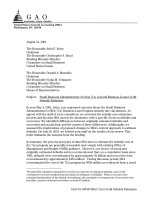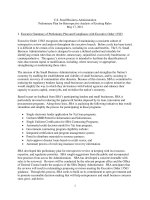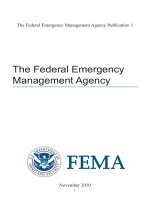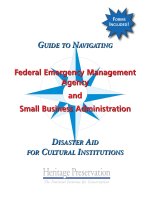Federal Emergency Management Agency and Small Business Administration ppt
Bạn đang xem bản rút gọn của tài liệu. Xem và tải ngay bản đầy đủ của tài liệu tại đây (1.41 MB, 66 trang )
GUIDE TO NAVIGATING
Federal Emergency Management
Agency
and
Small Business Administration
DISASTER AID
FOR
CULTURAL INSTITUTIONS
GUIDE TO NAVIGATING
Federal Emergency Management
Agency
and
Small Business Administration
DISASTER AID
FOR
CULTURAL INSTITUTIONS
FORMS
INCLUDED!
This guide is a project of Heritage Preservation in support of the Heritage Emergency National Task Force, a part-
nership of 40 national service organizations and federal agencies created to protect cultural heritage from the dam-
aging effects of natural disasters and other emergencies. The Task Force is co-sponsored by Heritage Preservation
and the Federal Emergency Management Agency.
For more than 30 years, Heritage Preservation (www.heritagepreservation.org) has been the national, nonprofit
advocate for the proper care of all cultural heritage—in museums, libraries, homes, and town squares. Heritage
Preservation works to save the objects and sites that embody our history, partnering with conservators, institutions,
civic groups, and concerned individuals across the nation who care about preserving our past.
The Institute of Museum and Library Services is the primary source of federal support for the nation’s 122,000
libraries and 17,500 museums. The Institute’s mission is to create strong libraries and museums that connect people
to information and ideas. The Institute works at the national level and in coordination with state and local organiza-
tions to sustain heritage, culture, and knowledge; enhance learning and innovation; and support professional devel-
opment.
The National Endowment for the Arts is a public agency dedicated to supporting excellence in the arts, both new
and established; bringing the arts to all Americans; and providing leadership in arts education. Established by
Congress in 1965 as an independent agency, the Endowment is the nation's largest annual funder of the arts, bring-
ing great art to all 50 states, including rural areas, inner cities, and military bases.
Heritage Preservation receives funding from the National Park Service, Department of the Interior. However, the
content and opinions contained in this publication do not necessarily reflect the views or policies of the Department
of the Interior.
Guide to Navigating
Federal Emergency Management Agency
and
Small Business Administration
Disaster Aid for Cultural Institutions
Produced by Heritage Preservation
in support of the
Heritage Emergency National Task Force
Made possible by funding from the
Institute of Museum and Library Services
and the
National Endowment for the Arts
Important!
This guide was originally published in July 2008 and updated January 2009. However, the federal
government policies and forms included in this publication are subject to change. Heritage
Preservation will make every effort to maintain the most up-to-date information on its Web site.
We encourage you to visit www.heritagepreservation.org/federal for updates.
ii
January 2009
iii
January 2009
Table of Contents
The contents of this publication are also available online at
www.heritagepreservation.org/federal.
Application Process 1
Applying for Small Business Administration Assistance 5
Applying for Federal Emergency Management Agency Assistance 7
Appendix A: State Emergency Management Agencies A1
Appendix B: FEMA Disaster Assistance Policy
9521.3 Private Nonprofit (PNP) Facility Eligibility B1
Appendix C: FEMA Disaster Assistance Policy
9521.2 Private Nonprofit Museum Eligibility C1
Appendix D: FEMA Disaster Assistance Policy
9524.6 Collection and Individual Object Eligibility D1
Appendix E: FEMA Disaster Assistance Policy
9524.9 Replacement of Animals Associated with Eligible Facilities E1
Appendix F: SBA Disaster Business Loan Filing Requirements and Form (two copies) F1
Appendix G: IRS Form 8821 (two copies) and Instructions G1
Appendix H: FEMA Immediate Needs Funding (INF) H1
Appendix I: FEMA Request for Public Assistance Form (two copies) I1
Appendix J: FEMA Private Nonprofit (PNP) Facility Questionnaire (two copies) J1
iv
January 2009
1
January 2009
This publication is a general guide to seeking federal funding to aid in disaster response and recovery. The steps
outlined here are based on current federal policies, some of which are under review. Heritage Preservation has tried to
ensure the accuracy of the information provided. However, Heritage Preservation assumes no liability for any loss or
damage caused by errors or omissions in this publication. Please read carefully the policies and regulations cited.
Application Process
1. Has a Presidential declaration been issued?
Federal disaster assistance is available only if the President declares a federal emergency or
major disaster. To find out if a declaration has been issued, check
www.fema.gov/news/disasters.fema or call your state or local emergency management agency
(see the blue pages in your phone book or Appendix A).
In some circumstances, Small Business Administration (SBA) loans may be available without a
presidential declaration; check with SBA for their disaster declarations (see page 5 for contact
information).
2. Who is eligible to apply for assistance?
Libraries, museums, archives, and all other collecting institutions open to the general public may
apply for Federal Emergency Management Agency (FEMA) assistance if they are:
1. an eligible private nonprofit*
2. part of a state, local, or tribal government
3. open to the public.
* Carefully review the appropriate FEMA policies: (1) 9521.3 Private Nonprofit Facility
Eligibility, which states that museums, zoos, libraries, and arts organizations may be eligible
(see Appendix B), and (2) 9521.2 Private Nonprofit Museum Eligibility, which states: “private
nonprofit museums are confined facilities which are constructed or manufactured whose
primary purposes are to: preserve a documented collection of artistic, historic, scientific or
other objects, and exhibit the documented collection to the general public.” (See Appendices
C & E.)
3. Where should we apply for assistance?
Nonprofit libraries, museums, arts organizations, and all other collecting institutions open to the
general public:
• Foremergencyprotectivemeasuresanddebrisremoval,applydirectlytoFEMAPublic
Assistance (see Appendix I).
• Forpermanentrepairsand/orcollectionsstabilization,applyforaloanfromtheSBA(see
page 5). If the SBA declines the loan application or the damages exceed the amount of the
loan, the organization may then apply to FEMA for further assistance.
2
January 2009
State, local, or tribal government libraries, museums, archives, and all other collecting
institutions open to the general public may apply to FEMA as part of their state, local, or tribal
government’s application to FEMA for debris removal, permanent repairs, and/or collections
stabilization. (In some cases, a state may designate more than one of its agencies as being
appropriate to make application to FEMA.)
Applications to FEMA or SBA: As long as an application is made to one of these programs by
the stated deadline, the applicant will be assured of acceptance into and eligibility for either
program.
4. What financial support is available?
SBA Support: The SBA can provide low-interest Physical Disaster Loans of up to $1.5 million
to repair or replace damaged real estate, equipment, inventory, and fixtures. The loan may be
increased by as much as 20 percent to protect the property against future disasters of the same
type. These loans cover uninsured or under-insured losses.
FEMA Support: All FEMA assistance is on a reimbursement basis for documented expenses—
in other words, you have to pay for services and supplies and then submit receipts to be
reimbursed by an agency of your state.
The minimum federal cost share is 75 percent of the eligible costs; however, the percentage may
be changed for a particular disaster. If your facility meets the eligibility criteria and deadlines for
applying for assistance, FEMA may offer reimbursement for:
• costsincurredfordebrisremoval(FEMACategoryA)
• costsincurredforemergencyprotectivemeasures,collectionsstabilizationandtreatment
(FEMA Category B)
• costsincurredforpermanentwork(repair,restoreorreplacedamagedfacility)(FEMA
Category E).
Collections: The FEMA Collection and Individual Object Eligibility Policy 9524.6 (Appendix
D) states that funding may be available for damaged collections and objects of eligible public or
private nonprofit facilities when the collections are:
• ondisplayorinstorageinapublicorprivatenonprofitfacility,includingoutdoorsculpture
and public art installations, and
• accessionedandcataloguedand/orinventoried.
This includes collections in state, local, or tribal government libraries, museums, archives, arts
organizations, and all other collecting institutions that meet FEMA’s eligibility criteria.
Replaceable Library Books and Publications: FEMA will fund treatment of “special library
collections” but not replacement of rare books and other fragile materials. General library books
and publications are subject to the provisions of 44 CFR §206.226(i).
3
January 2009
Animals: FEMA Replacement of Animals Associated with Eligible Facilities Policy 9524.9
(Appendix E) states that funding may be available for replacement of destroyed or damaged
animals owned by an eligible applicant. These animals may include, but are not limited to:
• Policeanimalsandtrainedandcertifiedrescuedogs.
• Animalsinmuseums,zoos,orpubliclyownednaturecenters.
• Taxidermyspecimenslocatedinaneligiblefacility.
• Animalsusedbyrehabilitationfacilitiesaspartofdiagnosisortreatment.
IMPORTANT: If you qualify for FEMA support, funds will be disbursed by the state emergency
management agency. You will not receive a check directly from FEMA.
4
January 2009
5
January 2009
Applying for Small Business Administration Assistance
After a Presidential Disaster Declaration, the usual procedure is for FEMA and SBA to set up
Field Offices in the affected area(s). Both agencies issue press releases and widely disseminate
information about how to contact their Field Offices.
If you have difficulty in locating a local SBA contact, call the Customer Service Center at
1-800-659-2955; visit www.sba.gov/services/disasterassistance/index.html; or e-mail
Your state emergency management agency (EMA) may also be able to assist you. To find your
state EMA, see Appendix A or www.fema.gov/about/contact/statedr.shtm.
1. When should we apply to the SBA?
If you are a private nonprofit organization that does not provide a critical service (power,
water, sewer, wastewater treatment, communications, and emergency medical care), apply
to the SBA for funding for permanent repair work (to repair, restore, or replace a damaged
facility). Collecting institutions must apply to SBA before applying to FEMA for this permanent
work. Private nonprofit organizations may apply to FEMA for emergency work (such as debris
removal) at the same time they apply to SBA for permanent work.
Cultural institutions under the umbrella of a state, local, or tribal government do not qualify and
therefore do not apply to SBA for disaster assistance; they must apply directly to FEMA.
2. What do we need to submit?
• SBADisasterBusinessLoanApplicationform(alsofornonprofits).(See Appendix F.)
• IRSForm8821—TaxInformationAuthorization(see Appendix G). You need to include with
the form:
•yourinstitution’sthreemostrecenttaxreturns
•acurrentbusinessbalancesheet
•currentprofitandlossstatement
•currentscheduleofliabilities
•abriefdescriptionofthedamagetorealestateandcontents
•yourinsuranceinformation.
3. Where can we get help with the application?
Consult the Disaster Business Loan Filing Requirements (see Appendix F).
SBA will help you complete your application and answer specific questions. SBA usually has
loan officers in the disaster area to help you and will announce locations where you can get help
in filling out your application.
6
January 2009
To locate a local SBA contact or for help with the application, call the SBA Customer Service
Center at 1-800-659-2955 or e-mail
4. Where do we send the application?
When you have completed your application, either drop it off at any of SBA’s disaster offices
or mail it to: SBA Disaster Assistance, Disaster Processing and Disbursement Center, 14925
Kingsport Road, Ft. Worth, TX 76155-2243.
5. What happens then?
SBA will verify your losses and review your application:
• SBAwillcheckyourapplicationforcompletenessandletyouknowifmoreinformationis
needed.
• AnSBAlossverifierwillmakeanappointmenttoinspectyourdisaster-damagedproperty
and to make an estimate of the cost to fully repair or replace your damaged property.
• AnSBAloanofficerwillcontactyoutodiscussyourapplicationandapreliminary
recommendation. This is not the final decision. After a supervisor reviews the
recommendation, SBA will mail you written notice of its decision on your loan request.
• Anapprovalordeclinedecisionisusuallygivenwithinthreeweeksafterreceivinga
completed loan application.
SBA will help close the loan and disburse the funds:
• Uponapprovalofyourloanrequest,SBAwillsendyouloanclosingdocumentsdescribingall
loan terms and conditions.
• SBAwillletyouknowifadditionalinformationisneeded,suchascopiesofpropertydeeds,
titles to vehicles, and leases.
• SBAwillgiveyouwritteninstructionsandofferhelpforcompletingalltheloandocuments.
• SBAwillsendyouloanfundsafteryoureturntheloandocuments.Withlargerloans,funds
are disbursed in stages as you make the repairs. You must maintain receipts to document
expenditures and submit periodic progress reports to obtain additional disbursements.
After full disbursement of your loan, SBA will send your file to a servicing office (SBA or other
servicing organization) until it is paid in full. SBA may also sell your loan.
If you are not eligible for an SBA loan or the amount you need exceeds your SBA loan, you may
apply for FEMA assistance.
7
January 2009
Applying for FEMA Public Assistance
After a Presidential Disaster Declaration, the usual procedure is for FEMA and SBA to set up
Field Offices in the affected area(s). Both agencies issue press releases and widely disseminate
information about how to contact their Field Offices. If you have difficulty in locating a FEMA
Field Office, contact your state emergency management agency (see Appendix A or
www.fema.gov/about/contact/statedr.shtm).
1. When should we apply for FEMA Public Assistance?
After a disaster has been declared, FEMA and your state emergency management office will
schedule Applicant Briefings in areas affected by the disaster. Notices will appear in local
newspapers, on local radio stations, and possibly on the Web site of your state emergency
management office. At Applicant Briefings, FEMA Public Assistance representatives and state
officials will explain the process, and you will fill out and submit a Request for Public Assistance
(RPA) application form (see details below). Briefings take place anywhere from one to four
weeks after a disaster has been declared. If you undertake emergency work (Category B) actions
(such as having debris removed from your site or stabilizing your building or collection) before
a briefing, be sure to thoroughly document your expenses and retain receipts.
If you are a private nonprofit institution (PNP):
• ApplydirectlytoFEMAfordisasterassistanceforemergencywork(suchasdebrisremoval;
see Appendix H: Immediate Needs Funding) after the disaster declaration has been made.
• AllPNPapplicationsfordisasterassistanceforpermanentwork(suchasrepairing,restoring,
or rebuilding a damaged facility) will be referred to the SBA to determine eligibility for low-
interest loans. If the SBA declines the loan application or the damages exceed the amount of
the loan, the application will automatically be sent to FEMA for further consideration.
If you are part of a state, local, or tribal government:
• ApplydirectlytoFEMAfordisasterassistance.SBAdoesnotassiststate,local,ortribal
governmental institutions. Check with your parent agency to see if they are filing an
application on behalf of all local government entities that includes your organization. If this
information is unavailable, submit the form yourself to be sure you don’t miss the filing
deadline. Any duplicate RPAs will be consolidated during the review process.
2. What forms do we need to complete?
All applicants (private nonprofit and governmental) must file a Request for Public Assistance
(RPA), form 90-49 (see Appendix I). This form does not require that you describe specific
damages—you may file it even if you haven’t been able to perform a damage assessment. This
form is Appendix I, or you may download it at www.forms.gov,
www.heritagepreservation.org/pdfs/rpa.pdf, or (you must download the
DocNet software). Or you can contact your FEMA Field Office.
8
January 2009
Private nonprofit applicants must also file a FEMA Private Nonprofit (PNP) Facility
Questionnaire, form 90-121 (see Appendix J). You can also download this form from
www.heritagepreservation.org/pdfs/FEMA90-121.pdf or . You must
include the following with this form:
• yourinstitution’staxexemptioncertificate
• yourinstitution’sorganizationalcharterorbylaws
• proofoffacilityownership,ifowned(e.g.,copyofdeedorpropertytaxassessment)
• proofoflegalresponsibilitytorepairthefacility(e.g.,leaseagreement)
• acopyofyourinstitution’sinsurancepolicy.
Submit these forms at the Applicant Briefing (or as instructed by a FEMA Public Assistance
Coordinator). Deadlines for applying/filing for assistance will be publicized and are usually 30
days after the disaster declaration.
3. Where can we find help?
For FEMA Public Assistance policy guidance, contact your Field Office or visit
www.fema.gov/government/grant/pa/policy.shtm.
4. What happens then?
After a Request for Public Assistance (RPA) and, where relevant, the Private Nonprofit Facility
Questionnaire have been filed, you are issued an identification number if you are an eligible
applicant. Each RPA is assigned to a FEMA Public Assistance Coordinator, who is responsible
for setting up a “kick-off” meeting with each applicant. At this time more detailed information
is gathered about the damages, and the plan to repair the damages is used to prepare a Project
Worksheet. It is important that you have documentation of the damage, including:
• statements,invoices,timesheets,andanyotherdocumentationofcostsincurred(itspeeds
the process to have this documentation summarized, if possible)
• photographsofthedamage,workinprogressaddressingthedamage,andanycompleted
work, especially if you must do work before it is inspected by FEMA
• anyestimateofworkstilltobedone,ifpractical.
You are encouraged to consult the FEMA policies regarding collections stabilization and
treatment (see Appendices D & E).
After the filing deadline, your state submits a funding request to FEMA for review and approval.
Your state will reimburse you for eligible work. You must continue to provide documentation
of your incurred costs to your Public Assistance Coordinator even after you have received your
funds.
A1
January 2009
Alabama Emergency Management
Agency
5898 County Road 41
P.O. Drawer 2160
Clanton, Alabama 35046-2160
(205) 280-2200
(205) 280-2495 FAX
ema.alabama.gov/
Alaska Division of Emergency Services
P.O. Box 5750
Fort Richardson, Alaska 99505-5750
(907) 428-7000
(907) 428-7009 FAX
www.ak-prepared.com
American Samoa Territorial Emergency
Management Coordination
P.O. Box 1086
Pago Pago, American Samoa 96799
(011)(684) 699-6415
(011)(684) 699-6414 FAX
Arizona Division of Emergency
Management
5636 E. McDowell Rd.
Phoenix, Arizona 85008
(602) 244-0504; (800) 411-2336 Toll-Free
www.dem.azdema.gov
Arkansas Department of Emergency
Management
Bldg. # 9501
Camp Joseph T. Robinson
North Little Rock, Arkansas 72199-9600
(501) 683-6700
(501) 683-7890 FAX
www.adem.arkansas.gov
California Governor’s Office of
Emergency Services
3650 Schriever Ave.
Mather, California 95655-4203
(916) 845-8510
(916) 845-8511 FAX
www.oes.ca.gov
Colorado Division of Emergency
Management
9195 East Mineral Ave., Suite 200
Centennial, Colorado 80112
(720) 852-6600
(720) 852-6750 FAX
www.dola.state.co.us/dem/index.html
Connecticut Department of Emergency
Management and Homeland Security
360 Broad St.
Hartford, Connecticut 06105
(860) 566-3180
(860) 247-0664 FAX
www.ct.gov/demhs/site/default.asp
Delaware Emergency Management
Agency
165 Brick Store Landing Rd.
Smyrna, Delaware 19977
(302) 659-3362
(302) 659-6855 FAX
www.dema.delaware.gov
District of Columbia Emergency
Management Agency
2720 Martin Luther King, Jr., Ave., SE
Washington, D.C. 20032
(202) 727-6161
(202) 673-2290 FAX
www.dcema.dc.gov
Appendix A: State Emergency Management Agencies
A2
January 2009
Florida Division of Emergency
Management
2555 Shumard Oak Blvd.
Tallahassee, Florida 32399-2100
(850) 413-9969
(850) 488-1016 FAX
www.floridadisaster.org
Georgia Emergency Management
Agency
P.O. Box 18055
Atlanta, Georgia 30316-0055
(404) 635-7000
(404) 635-7005 FAX
www.gema.state.ga.us
Guam Homeland Security/Office of Civil
Defense
221B Chalan Palasyo
Agana Heights, Guam 96910
(671) 475-9600
(671) 477-3727 FAX
www.ghs.guam.gov
Hawaii State Civil Defense
3949 Diamond Head Rd.
Honolulu, Hawaii 96816-4495
(808) 733-4300
(808) 733-4287 FAX
www.scd.hawaii.gov
Idaho Bureau of Homeland Security
4040 Guard St., Bldg. 600
Boise, Idaho 83705-5004
(208) 422-3040
(208) 422-3044 FAX
www.bhs.idaho.gov
Illinois Emergency Management Agency
2200 S. Dirksen Pkwy.
Springfield, Illinois 62703
(217) 782-2700
(217) 524-7967 FAX
www.state.il.us/iema
Indiana Department of Homeland
Security
302 West Washington St., Room E-208 A
Indianapolis, Indiana 46204-2767
(317) 232-3986
(317) 232-3895 FAX
www.in.gov/dhs
Iowa Homeland Security & Emergency
Management Division
7105 N.W. 70th Ave.,
Camp Dodge, Building W-4
Johnston, Iowa 50131
(515) 725-3231
(515) 281-7539 FAX
www.iowahomelandsecurity.org
Kansas Division of Emergency
Management
2800 S.W. Topeka Blvd.
Topeka, Kansas 66611-1287
(785) 274-1409
(785) 274-1426 FAX
www.kansas.gov/kdem
Kentucky Division of Emergency
Management
EOC Building
100 Minuteman Parkway, Bldg. 100
Frankfort, Kentucky 40601-6168
(502) 607-1682
(502) 607-1614 FAX
www.kyem.ky.gov
A3
January 2009
Louisiana Governor’s Office of
Homeland Security and Emergency
Preparedness
7667 Independence Blvd.
Baton Rouge, Louisiana 70806
(225) 925-7500
(225) 925-7501 FAX
www.ohsep.louisiana.gov
Maine Emergency Management Agency
72 State House Station
45 Commerce Dr., Suite #2
Augusta, Maine 04333-0072
(207) 624-4400
(207) 287-3180 FAX
www.maine.gov/mema
Commonwealth of the Northern
Mariana Islands Emergency
Management Office
Caller Box 10007, Capital Hill
Saipan, Mariana Islands 96950
(670) 322-9529
(670) 322-9500 FAX
www.cnmiemo.gov.mp
National Disaster Management Office
Office of the Chief Secretary
P.O. Box 15
Majuro, Republic of the Marshall Islands
96960-0015
(011)(692) 625-5181
(011)(692) 625-6896 FAX
Maryland Emergency Management
Agency
5401 Rue Saint Lo Dr.
Reisterstown, Maryland 21136
(410) 517-3600; (877) 636-2872 Toll-Free
(410) 517-3610 FAX
www.mema.state.md.us
Massachusetts Emergency Management
Agency
400 Worcester Rd.
Framingham, Massachusetts 01702-5399
(508) 820-2000
(508) 820-2030 FAX
www.mass.gov/mema
Michigan Division of Emergency
Management
4000 Collins Rd.
P.O. Box 30636
Lansing, Michigan 48909-8136
(517) 333-5042
(517) 333-4987 FAX
www.michigan.gov/emd
National Disaster Control Officer,
Federated States of Micronesia
P.O. Box PS-53
Kolonia, Pohnpei - Micronesia 96941
(011)(691) 320-8815
(001)(691) 320-2785 FAX
Minnesota Homeland Security and
Emergency Management Division
444 Cedar St., Suite 223
St. Paul, Minnesota 55101-6223
(651) 201-7400
(651) 296-0459 FAX
www.hsem.state.mn.us
Mississippi Emergency Management
Agency
P.O. Box 5644
Pearl, Mississippi 39288-5644
(601) 933-6362; (800) 222-6362 Toll-Free
(601) 933-6800 FAX
www.msema.org
A4
January 2009
Missouri Emergency Management
Agency
P.O. Box 116
Jefferson City, Missouri 65102
(573) 526-9100
(573) 634-7966 FAX
www.sema.dps.mo.gov
Montana Disaster and Emergency
Services
1900 Williams St.
Helena, Montana 59604-4789
(406) 841-3911
(406) 444-3965 FAX
www.dma.mt.gov/des/
Nebraska Emergency Management
Agency
1300 Military Rd.
Lincoln, Nebraska 68508-1090
(402) 471-7421
(402) 471-7433 FAX
www.nema.ne.gov
Nevada Division of Emergency
Management
2478 Fairview Dr.
Carson City, Nevada 89701
(775) 687-0300
(775) 687-0322 FAX
www.dem.state.nv.us
New Hampshire Homeland Security and
Emergency Management
33 Hazen Dr.
Concord, New Hampshire 03305
(603) 271-2231
(603) 223-3609 FAX
www.nh.gov/safety/divisions/bem
New Jersey Office of Emergency
Management
P.O. Box 7068
West Trenton, New Jersey 08628-0068
(609) 538-6050 Monday-Friday
(609) 882-2000 ext 6311 (24/7)
(609) 538-0345 FAX
www.ready.nj.gov
New Mexico Department of Homeland
Security and Emergency Management
13 Bataan Blvd.
Santa Fe, New Mexico 87504
(505) 476-9600
(505) 476-9635 Emergency
(505) 476-9695 FAX
www.nmdhsem.org
New York State Emergency
Management Office
1220 Washington Ave.
Building 22, Suite 101
Albany, New York 12226-2251
(518) 292-2200
(518) 322-4978 FAX
www.semo.state.ny.us
North Carolina Division of Emergency
Management
4713 Mail Service Center
Raleigh, North Carolina 27699-4713
(919) 733-3867
(919) 733-5406 FAX
www.nccrimecontrol.org
North Dakota Department of
Emergency Services
P.O. Box 5511
Bismarck, North Dakota 58506-5511
(701) 328-8100
(701) 328-8181 FAX
www.nd.gov/des
A5
January 2009
Ohio Emergency Management Agency
2855 West Dublin-Granville Rd.
Columbus, Ohio 43235-2206
(614) 889-7150
(614) 889-7183 FAX
ema.ohio.gov
Oklahoma Department of Emergency
Management
2401 Lincoln Blvd., Suite C51
Oklahoma City, Oklahoma 73105
(405) 521-2481
(405) 521-4053 FAX
www.ok.gov/OEM
Oregon Emergency Management
P.O. Box 14370
Salem, Oregon 97309-5062
(503) 378-2911
(503) 373-7833 FAX
www.oregon.gov/OMD/OEM
Palau National Emergency Management
Office
P.O. Box 100
Koror, Republic of Palau 96940
(011)(680) 488-2422
(011)(680) 488-3312
Pennsylvania Emergency Management
Agency
2605 Interstate Dr.
Harrisburg, Pennsylvania 17110-9463
(717) 651-2001
(717) 651-2040 FAX
www.pema.state.pa.us
Puerto Rico Emergency Management
Agency
P.O. Box 9066597
San Juan, Puerto Rico 00906-6597
(787) 724-0124
(787) 725-4244 FAX
www.gobierno.pr/AEMEAD/Inicio
Rhode Island Emergency Management
Agency
645 New London Ave.
Cranston, Rhode Island 02920-3003
(401) 946-9996
(401) 944-1891 FAX
www.riema.ri.gov
South Carolina Emergency Management
Division
2779 Fish Hatchery Rd.
West Columbia, South Carolina 29172
(803) 737-8500
(803) 737-8570 FAX
www.scemd.org
South Dakota Office of Emergency
Management
118 West Capitol Ave.
Pierre, South Dakota 57501
(605) 773-3231
(605) 773-3580 FAX
www.oem.sd.gov
Tennessee Emergency Management
Agency
3041 Sidco Dr.
Nashville, Tennessee 37204-1502
(615) 741-0001
(615) 242-9635 FAX
www.tnema.org
Texas Governor’s Division of Emergency
Management
5805 N. Lamar Blvd.
Austin, Texas 78752
(512) 424-2138
(512) 424-2444 FAX
www.txdps.state.tx.us/dem
A6
January 2009
Utah Division of Homeland Security
1110 State Office Building
SaltLakeCity,Utah84114
(801) 538-3400
(801) 538-3770 FAX
www.des.utah.gov/homelandsecurity
Vermont Emergency Management
Agency
103 South Main St.
Waterbury, Vermont 05671-2101
(802) 244-8721
(802) 244-8655 FAX
www.dps.state.vt.us/vem
Virgin Islands Territorial Emergency
Management
2-C Contant, A-Q Building
Virgin Islands 00820
(340) 774-2244
(340) 774-1491 FAX
Virginia Department of Emergency
Management
10501 Trade Court
Richmond, Virginia 23236-3713
(804) 897-6502
(804) 897-6506 FAX
www.vdem.state.va.us
State of Washington Emergency
Management Division
Building 20
Camp Murray, Washington 98430-5122
(253) 512-7000
(253) 512-7200 FAX
www.emd.wa.gov
West Virginia Division of Homeland
Security and Emergency Management
Building 1, Room EB-80
1900 Kanawha Blvd., East
Charleston, West Virginia 25305-0360
(304) 558-5380
(304) 344-4538 FAX
www.wvdhsem.gov
Wisconsin Emergency Management
2400 Wright St.
Madison, Wisconsin 53704
(608) 242-3232
(608) 242-3247 FAX
emergencymanagement.wi.gov/
Wyoming Office of Homeland Security
122 W. 25th St.
Cheyenne, Wyoming 82002
(307) 777-4663
(307) 635-6017 FAX
wyohomelandsecurity.state.wy.us
B1
January 2009
Appendix B: FEMA Disaster Assistance Policy
9521.3 Private Nonprofit (PNP) Facility Eligibility
I. Title: Private Nonprofit (PNP) Facility Eligibility
II. Date: July 18, 2007
III. Purpose: This policy relates to the repair, restoration, reconstruction, or replacement of
damaged facilities and provides guidance in determining the eligibility of private nonprofit
(PNP) organizations and facilities not specifically identified in Title 44 Code of Federal
Regulations (CFR) § 206.221.
IV. Scope and Audience: The policy is applicable to all major disasters declared on or after
the date of publication of this policy. It is intended for Federal Emergency Management
Agency (FEMA) personnel involved in making eligibility determinations under the Public
Assistance (PA) Program.
V. Authority: Section 406 of the Robert T. Stafford Disaster Relief and Emergency Assistance
Act(StaffordAct),42U.S.C.5121-5206,asamendedandDepartmentofHomeland
Security (DHS) Appropriations Act of 2007 (DHS Appropriations Act, 2007), P. L. 109-295,
§ 611, 120 Stat.1355 (2006), and 44 CFR §206.221.
VI. Background:
A. The guidelines for eligibility of PNP organizations and facilities have been refined over
the past several years as eligibility issues have surfaced. The regulatory definition of a PNP
organization and facility can be found in 44 CFR §206.221. However, PNP organizations
offer so many types of services that it is still necessary to provide additional policy guidance
regarding organizations and services listed in the regulations and in the preamble of the
final rule published at 58 Federal Register (FR) 47992, September 14, 1993. The terms,
“purposes,” “activities,” “uses,” and “services” as used in this policy are derived from the
governing statute, regulations, and customary usage and may overlap.
B. In the past, all PNPs had to be open to the general public. However, a careful reading
of legislative authorities made clear that in 1988, in amending the Disaster Relief Act of
1974, Congress intended that only facilities within the category of “other private nonprofit
facilities which provide essential services of a governmental nature” [as defined in 44 CFR
§206.221(e)(7)] must be open to the general public to be eligible for public assistance.
C. TheDisasterMitigationActof2000,amendedSection102(9)oftheStaffordAct,42U.S.C.
5122, adding “irrigation” facilities to the list of eligible PNP facilities, to the extent they
provide water for essential services of a governmental nature to the general public.
D. The DHS Appropriations Act, 2007 amends Sections 102 and 406 of the Stafford Act,
adding “performing arts facilities” and “community arts centers” to the list of eligible PNP
facilities providing essential services of a governmental nature. Note that these additional
eligible PNP applicants must also meet the eligibility criteria, detailed primarily in 44 CFR
§206, in order to receive disaster assistance.
B2
January 2009
E. The DHS Appropriations Act, 2007 also adds education to the definition of “critical
services” in Section 406 of the Stafford Act. These changes have been incorporated into the
existing policy, which is presented in its entirety below.
VII. Policy:
A. Applicants - Basic Statutory and Regulatory Requirements.
1. TheapplicantmusthavearulingletterfromtheU.S.InternalRevenueServiceor
satisfactory evidence from the State that it is a nonprofit organization doing business
under State law as outlined in 44 CFR §206.221(f).
2. The applicant must meet requirements as listed in 44 CFR §206.221 - §206.226,
including the need to own or operate an eligible facility and to be legally responsible
for disaster-related repairs.
3. The applicant must meet the requirements of the Civil Rights Act of 1964.
B. Facilities - Basic Statutory and Regulatory Requirements/Information.
1. The facility, at a minimum, must meet the criteria outlined in 44 CFR §206.221(e).
2. The facility must be primarily used for one of the services or facilities listed in 44 CFR
§206.221(e).
3. Certain types of facilities are not required to be open to the general public if they meet
the definition of an educational, utility, emergency, medical, or custodial care facility
[enumerated in 44 CFR §206.221(e)(1),(2),(4),(5),(6)]. Other types of private nonprofit
facilities that provide certain essential government type services to the general public,
which include PNP irrigation facilities [as defined in 44 CFR §206.221(e)(3)] and
facilities that provide “other essential government services” as defined in 44 CFR
§206.221(e)(7), and as listed in 4(g) below, must be open to the general public, (See
7C).
4. Eligible PNP Facilities. The following generally are eligible for assistance, and may be
subject to the requirements of paragraph F of this policy:
a. educational facilities [as defined in 44 CFR §206.221 (e)(1)],
b. utilities [as defined in 44 CFR §206.221 (e)(2)],
c. irrigation facilities [as defined in 44 CFR §206.221(e)(3)]
d. emergency facilities [as defined in 44 CFR §206.221 (e)(4)],
e. medical facilities [as defined in 44 CFR §206.221 (e)(5)],
f. custodial care facilities [as defined in 44 CFR §206.221 (e)(6)],
g. facilities that provide essential governmental services and which must be open
to the general public [as defined in 44 CFR §206.221(e)(7) and in the DHS
Appropriations Act, 2007] such as:
i. museums (see Disaster Assistance Policy DAP9521.2, PNP Museum
Eligibility),
ii. zoos,
iii. performing arts facilities - facilities whose primary purposes are the
presentation of live performances involving actors, singers, dancers,
B3
January 2009
musicians, performance groups and ensembles, and/or other performing
artists to the general public; or the production/facilitation of such
performances (e.g., creation of artistic works or productions, public
education, professional training, rehearsals, design and construction
of production materials). The facility may include, but is not limited
to: rehearsal and performance spaces, box office, audience spaces,
amphitheatres, outdoor stages, classrooms, and other areas dedicated to
performing arts production and presentation.
iv. community centers (see Disaster Assistance Policy DAP9521.1, Community
Center Eligibility),
v. community arts centers - facilities whose primary purposes are to offer
multi-purpose arts programming and/or to provide arts services that have
been designated, recognized or authorized by a State or local government.
Arts services may include, but are not limited to: art classes, performing arts
classes, arts administration, and management of public arts festivals. The
facility may include, but is not limited to: performance spaces, rehearsal
spaces, shared workspace for community artists, exhibition/gallery spaces,
classrooms, and studios.
vi. libraries,
vii. homeless shelters,
viii. senior citizen centers,
ix. shelter workshops, and
x. health and safety services of a governmental nature, including, for example:
•low-incomehousing(asdefinedbyFederal,Stateorlocallawor
regulation),
•alcoholanddrugtreatmentcenters,
•residencesandotherfacilitiesofferingprogramsforbatteredspouses,
•animalcontrolfacilitiesdirectlyrelatedtopublichealthandsafety,
•facilitiesofferingfoodprogramsfortheneedy,
•daycarecentersforchildren,and
•daycarecentersforindividualswithspecialneeds(e.g.,thosewith
Alzheimer’s disease, autism, muscular dystrophy, etc.).
5. Ineligible PNP Facilities. Some PNP facilities that might have been assisted prior to
1993 are no longer eligible under the governing statutes and regulations. Examples
include:
a. recreation facilities,
b. job counseling and training centers,
c. facilities for advocacy groups not directly providing health services,
d. housing (other than low-income),
B4
January 2009
e. cemeteries,
f. parking garages,
g. conference facilities,
h. facilities maintained by property owners’ associations such as roads and
recreational facilities (except those facilities that could be classified as utilities or
emergency facilities), and
i. daycare centers for purposes other than those described in paragraph 4 above.
C. Defining “open to the general public.” Being “open to the general public” and “providing
services to the general public,” are requirements for facilities that provide “other essential
governmental services” [as defined in 44 CFR §206.221(e)(7)]. Facilities that meet the
definition of an educational, utility, emergency, medical, or custodial care facility as defined
in 44 CFR §206.221(e) are exempt from this requirement.
1. A private nonprofit facility that provides “other essential governmental services” is
likely to meet the “open to the general public” requirement if:
a. It is open to the general public;
b. Membership fees, if any, are nominal;
c. Membership fees, if any, are waived in instances in which someone can show
inability to pay the fee.
2. A private nonprofit facility that provides “other essential governmental services”
[defined in 44 CFR §206.221(e)(7)] is not likely to meet the “open to the general
public” requirement if:
a. A membership fee is of such magnitude as to preclude access to the facility by a
significant portion of the community.
b. The membership fee clearly exceeds what would be considered an appropriate user
fee based upon a reasonable assumed use of a facility.
c. Membership is limited to a certain number of people in the community.
d. Membership is limited to a defined group of individuals who have a financial
interest in the facilities managed by the PNP (for example, a condominium
association).
e. Membership discriminates against certain discrete classes of people, or is limited
to individuals from some geographic area that is more restrictive than the
community from which the facility in question could normally be expected to
draw users.
D. FacilityEligibilityBasedonPrimaryUse.Evenwhenanorganizationthatownsthefacility
is an eligible PNP, the facility itself must be primarily used for eligible services. Space is the
primary consideration in determining if a facility is eligible.
1
Where certain spaces are used
both for eligible and ineligible purposes, eligibility is determined by looking at the time the
facility is used for eligible versus ineligible services.
1. A facility must have over 50 percent of its space dedicated to eligible uses in order for
any of the facility to be eligible. Common space (lobbies, restrooms, utility closets,
janitorial closets, elevators, stairs, parking, etc.) is not included in calculating the
B5
January 2009
proportion of eligible use. A facility is assessed as an entire structure and not its
individual parts such as a basement, floor, or building wing.
2. When space is not dedicated to specific activities, or is used for eligible and ineligible
purposes, primary use is determined by the amount of time used for eligible services.
3. Space dedicated to or primarily used for religious, political, athletic, recreational, or
vocational purposes, is not eligible for Public Assistance Program assistance under the
governing statutes and regulations.
4. FEMA will consider damages to the entire facility, not just to the portion occupied by
the eligible services. However, the assistance is in direct proportion to the percentage of
space dedicated to eligible services. The balance of costs to repair damages or replace a
facility will not be funded by FEMA.
5. Contents that are the responsibility of an ineligible occupant are not eligible for
reimbursement if damaged.
E. Ownership. There are instances when an eligible organization will use part of a facility for
eligible services and lease the remaining portion for an ineligible service or use. In other
situations an eligible organization may be a partial owner in a facility with an ineligible
organization. The following guidelines are to be used in determining the eligible costs for
such facilities.
1. Total Ownership by PNP. A facility must have over 50% of its space dedicated to an
eligible purpose/mission in order to be eligible.
a. If the facility meets the 50% threshold, then the eligibility of the repairs is in direct
proportion to the percentage of space dedicated to its eligible purpose/mission. In
any event, the applicant must repair the entire building. Exceptions to repairing
the entire building may be granted in unusual situations.
b. A facility that does not meet the 50% space threshold is not an eligible PNP
facility.
c. A Section 406 Hazard Mitigation grant would be eligible at the same percentage
as the repair. However, the applicant must mitigate the entire building if the
applicant opts to request the pro-rated mitigation project funding.
2. Partial Ownership by PNP. Reimbursement depends upon the percentage of
ownership, amount of space being occupied by the applicant and amount of space
dedicated to eligible services. The grant assistance may fund work in any part of the
facility; however, reimbursement is contingent upon the entire facility being repaired.
Exceptions to repairing the entire building may be granted in unusual situations.
a. The eligible applicant: (1) must own more than 50 percent of the facility, and (2)
must occupy and use for eligible services more than 50 percent of the facility’s
space at the time of the disaster. If the eligible space meets that threshold, funding
is in direct proportion to the percentage of space dedicated to the eligible use.
b. The percentage eligible cannot exceed the percentage represented by the space
being occupied by the applicant. For example, if the applicant owns 70 percent of
the building but only uses 60 percent for its eligible purposes, then the maximum
eligible percentage is 60 percent.
c. A Section 406 Hazard Mitigation grant would be eligible at the same percentage as









